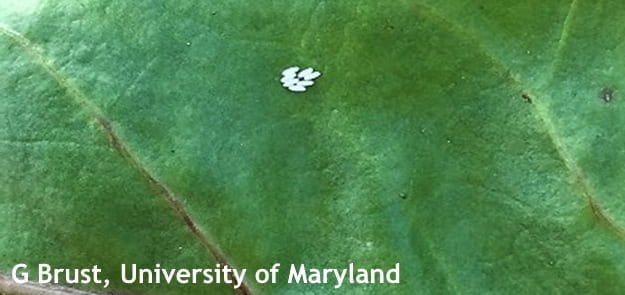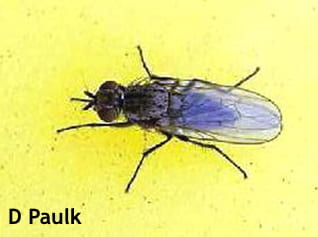Jerry Brust, IPM Vegetable Specialist, University of Maryland; jbrust@umd.edu
Spinach and beet leafminers have been around in low numbers for the past few weeks, which is a couple of weeks ahead of schedule but have increased rapidly in the last 5-6 days. These leaf miners are found in beets, swiss chard and spinach but I usually find them more in swiss chard than spinach. Both of these leafminers are a type of blotch leafminer, creating irregularly shaped mines. These flies attack crops and weeds in the plant family Chenopodiaceae, which includes chard, beets, and spinach and the weed lamb’s quarters. Both fly species are very similar, but the spinach leafminer may also feed on Solanaceous crops, such as peppers.
Adults are small flies about 1/3 inch in length and gray to brown. Larvae are whitish and cone-shaped. Flies of both species overwinter as pupae in the soil. In April and May, flies emerge and lay easily seen bright white eggs in groups of 4-8 on the underside of leaves (Fig. 1). Eggs hatch and larvae begin feeding between leaf tissues creating mines (Fig. 2). As the larvae feed and develop, they create areas of dead tissue where they have fed. These areas are opaque at first and then later turn brown (Fig. 3). Once inside the leaf tissue larvae are difficult to control. The larvae are active for about two to three weeks, before dropping to the ground and pupating in the soil. The entire life cycle is 30-40 days. There are three to four generations per season. Once the summer is over, leafminers will overwinter as a puparium in the soil emerging in early spring the next year to start the cycle again.
If you have seriously infested spinach or swiss chard now and you plan to make additional plantings of these crops this season it should be done in a different area of the field because of pupae still in the soil. Once the spinach or chard is planted in a new area a row cover or chemicals can be used to protect the plants and keep the leafminer flies that will emerge from the previous infested sites from laying eggs. Because these leafminers feed mostly on one crop group and some weeds that include chickweed, pigweed and lamb’s quarters, weed control and crop rotation are important management tools.
Chemical controls such as dinotefuran, thiamethoxam and spinetoram (spinetoram also has translaminar activity and if combined with an adjuvant is more effective against larvae) are foliar and soil controls for use in spinach. Chemical controls for leaf miners in other crops are more limited, so check the 2020-2021 Mid-Atlantic Commercial Vegetable Production Recommendation guide and always follow label instructions. For organic production spinosad (Entrust) with horticulture oil can provide good control especially if used at or before egg laying and has only minor impacts on natural enemies. Neem oil can be used to prevent egg laying but is not as effective as spinosad. As always thorough coverage is necessary for good control which includes getting the material to the underside of the leaf.
Figure 1. Leafminer eggs are white and laid on underside of leaves
Figure 2. Leafminer eggs have hatched and larvae are mining between leaf layers
Figure 3. As larvae grow their damage becomes more pronounced
Seed Corn and Other Maggots
Just a note to say I have gotten several calls, pictures and descriptions of seed maggots attacking the seeds of peas, lima, snap and kidney beans, cucumber and cantaloupe transplants and corn seed. Often no maggots are found in the hollowed out seeds or transplants because the fly larvae have already pupated and it is very difficult if not impossible to find the pupal case in soil. This has been a really good year for the flies to remain active in our vegetable fields far longer than they normally do. Flies do well in cooler wet weather, which we have had the past month and a half. I wrote an article about these flies back on the 10th of April as weather outlooks were predicting cool and wet conditions for the next few weeks—didn’t realize it would be for the next month. Nothing can be done for the damaged seed or transplants now. Growers will have to replant or re-transplant the missing plants. If seed maggot adults (Fig. 4), which are thin brown/gray flies a little smaller than a house fly that tend to swarm around the soil are still active in your field you’ll need to treat before replanting (see 2020-2021 Mid-Atlantic Commercial Vegetable Production Recs guide).
Figure 4. Adult seed maggot




